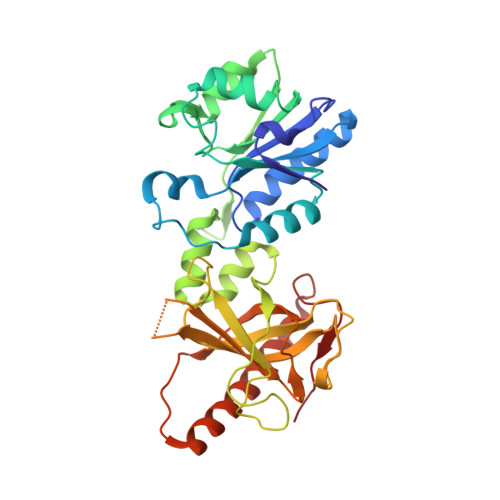Quaternary Organization in a Bifunctional Prokaryotic Fad Synthetase: Involvement of an Arginine at its Adenylyltransferase Module on the Riboflavin Kinase Activity.
Serrano, A., Sebastian, M., Arilla-Luna, S., Baquedano, S., Pallares, M.C., Lostao, A., Herguedas, B., Velazquez-Campoy, A., Martinez-Julvez, M., Medina, M.(2015) Biochim Biophys Acta 1854: 897
- PubMed: 25801930
- DOI: https://doi.org/10.1016/j.bbapap.2015.03.005
- Primary Citation of Related Structures:
4UZE, 4UZF - PubMed Abstract:
Prokaryotic FAD synthetases (FADSs) are bifunctional enzymes composed of two modules, the C-terminal module with ATP:riboflavin kinase (RFK) activity, and the N-terminus with ATP:FMN adenylyltransferase (FMNAT) activity. The FADS from Corynebacterium ammoniagenes, CaFADS, forms transient oligomers during catalysis. These oligomers are stabilized by several interactions between the RFK and FMNAT sites from neighboring protomers, which otherwise are separated in the monomeric enzyme. Among these inter-protomer interactions, the salt bridge between E268 at the RFK site and R66 at the FMNAT-module is particularly relevant, as E268 is the catalytic base of the kinase reaction. Here we have introduced point mutations at R66 to analyze the impact of the salt-bridge on ligand binding and catalysis. Interestingly, these mutations have only mild effects on ligand binding and kinetic properties of the FMNAT-module (where R66 is located), but considerably impair the RFK activity turnover. Substitutions of R66 also modulate the ratio between monomeric and oligomeric species and modify the quaternary arrangement observed by single-molecule methods. Therefore, our data further support the cross-talk between the RFK- and FMNAT-modules of neighboring protomers in the CaFADS enzyme, and establish the participation of R66 in the modulation of the geometry of the RFK active site during catalysis.
- Departamento de Bioquímica y Biología Molecular y Celular, Facultad de Ciencias, and Instituto de Biocomputación y Física de Sistemas Complejos (BIFI)-Joint Unit BIFI-IQFR, Universidad de, Zaragoza, Spain.
Organizational Affiliation:


















